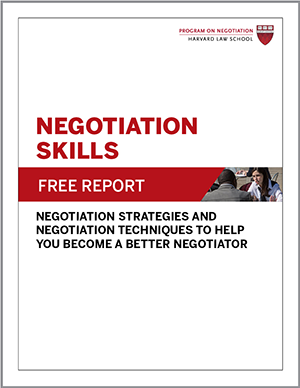
Negotiators often try to overcome their differences of opinion about how future events will unfold through persuasion techniques. A more fruitful approach might be to “bet” on your differing views with a contingent agreement. By adding incentives or penalties based on future performance to your contract, you protect both parties against risk.
Suppose that a homeowner is skeptical of a contractor’s promise to complete an extensive remodeling project within six months. Differing forecasts can breed suspicion and stand in the way of agreement. The homeowner could ask the contractor to agree to pay a penalty in the event of delays or offer a bonus if the contractor finishes early, or both. Similarly, companies often tie CEO salaries to stock prices, and publishers link authors’ royalties to book sales.
Adding to the benefits of negotiation in business, a contingent agreement allows negotiators to capitalize on their differences, thereby avoiding the need to compromise or decide who is “right.” A contingent agreement also lowers the risk of noncompliance, decreases the odds of litigation, and reduces the need to renegotiate deal terms. Among the many negotiation skills we can use to get a better deal, contingent agreements are among the most useful.
Contingent Agreement Stories in the News
When bidding to purchase Groupon in late 2010, Google tried to hedge against uncertainty regarding the Internet deal company’s future performance by structuring a high percentage of its $6 billion offer as “earn-outs”—payments Groupon would receive only if it hit certain performance targets. (Ultimately, however, this contingent agreement was unable to bridge the gap between the two companies when Groupon balked over possible antitrust delays).
In another mergers and acquisitions (M&A) negotiation in October 2010, the Paris-based international pharmaceutical company Sanofi-Aventis SA made an $18.5 billion, $69-per-share takeover bid for the American biotechnology company Genzyme Corp. Sanofi was hoping to boost revenues, as patents on some of its key products were expiring.
Genzyme shunned the offer, saying it was too low, and refused to open its books to Sanofi. Genzyme felt Sanofi was undervaluing its star pipeline product, a potential multiple sclerosis (MS) drug. Based on an encouraging mid-stage research trial, Genzyme predicted that Campath, originally a leukemia drug, would capture one-quarter of the $13 billion global MS market. By contrast, Sanofi estimated the drug would sell about $700 million annually, the Wall Street Journal reports.
The differing predictions set the stage for a contingent agreement in which Sanofi and Genzyme could bet on Campath’s success in the MS market. Breaking months of impasse, financial advisers for both companies began to negotiate contingent value rights (CVR) that would give shareholders an added benefit if Genzyme hit a future benchmark tied to sales of Campath. The contingent agreement ultimately helped the parties reach a deal: On February 16, 2011, Sanofi announced it was acquiring Genzyme for $20.1 billion.
Hidden Hazards of a Contingent Agreement
As we saw in the case of Sanofi and Genzyme, when two parties legitimately disagree about future outcomes that affect their deal, they might be able to bridge the gap by betting on their beliefs and negotiating a contingent agreement. Contingent agreements are common in M&A, professional athletics, and building projects. But many situations that require negotiation could be improved by structuring incentives and penalties rather than resorting to persuasion techniques that may have low odds of success.
Before adding a contingent agreement to your deal, consider these four potential hazards:
- Unequal information. If the other side has access to better information than you do, you might unwittingly agree to a bad deal. Check the validity of your predictions before signing on the dotted line.
- Distorted incentives. An unrealistic contingent agreement could create a conflict of interest. If your contractor rushes to meet an imposed deadline to avoid incurring penalties, you might not be pleased with the finished project. Set terms that are reasonable.
- Ties that bind. A contingent agreement creates an ongoing relationship, as the two sides will need to assess the final terms of their agreement at a later date. If you’d rather not deal with someone again, a contingent contract may not be a good idea.
- To be enforceable, a contingent agreement must be clear and measurable. Don’t make a bet on an event that is ambiguous or otherwise difficult to measure.
Have you ever used a contingent agreement in a contract, and if so, how did it play out?





